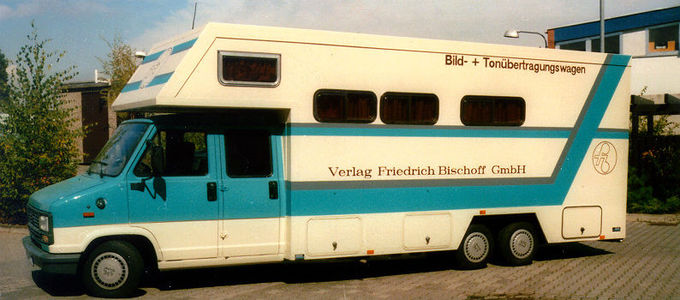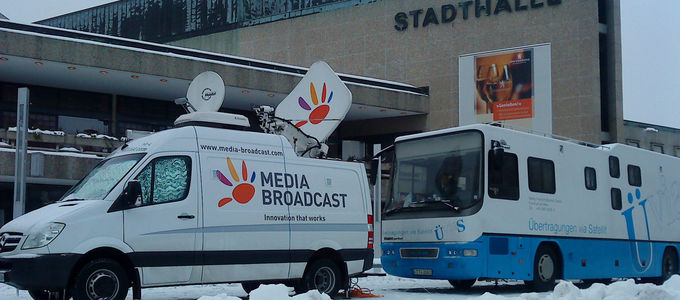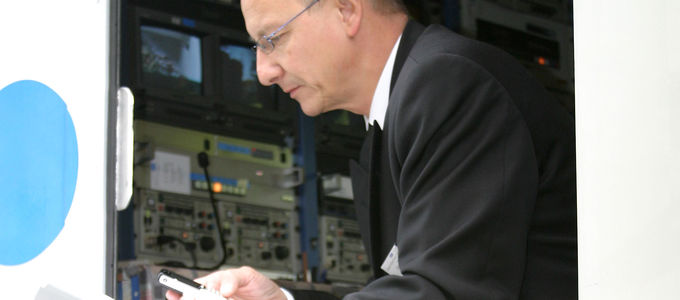
When millions of brothers and sisters in faith around the globe are once again united for this year’s Pentecost divine service, the New Apostolic Church will be celebrating a special anniversary: for the last 25 years, the Great Transmission has also been sent out to all the nations, namely by satellite. Following are some insights into what is not exactly every-day infrastructure:
It seems like such a commonplace affair — you simply take your seat in the congregation and enjoy the Chief Apostle service on the screen along with everyone else. However, the technical effort going on behind the scenes is quite enormous: eleven satellites, ten ground stations, fibre optic cables, internet, and—in parts of Africa—broadcast television, comprise the signal path leading from the cameras in Zambia to those attending the divine service in some 100 countries on five continents.
The history — From sound to picture
Things used to be quite different, however: many today can still picture the honeycomb braiding that covered the loudspeakers from which the audio feed from telephone transmissions used to emanate. This was a regular feature since 1949 — until 1983, when Chief Apostle Hans Urwyler came back from North America and enthusiastically related his experience of the first video transmissions there.
This was just the nudge that was needed for the Church-owned Bischoff publishers to begin teaching the divine service pictures—which they had previously only published in print-format in the “Our Family” magazine—to move. The earliest recordings by a small transmission system at first only managed to cover short distances — for example, at the premier in December 1983 in Saarbrücken, in which the signal was sent from the Saarland-Halle into some adjacent rooms. The new technology began making its rounds, especially in Southwestern Germany.
The next step: from the local town to the entire region
Since everything was working well and interest was growing, the technology soon had to become more portable. So it was that the first Outside Broadcast Vehicle—which was mostly a home-made project—came into being. The rolling director’s office was first put to work in 1985 in Waldshut, and from then on found itself travelling constantly throughout all of Western Europe. But the scope of the transmissions was soon to increase beyond the original area of application. This was the goal that Chief Apostle Urwyler set two years later.
The first small step was made at the Pentecost divine service in Fellbach, when his successor, Richard Fehr assumed the Chief Apostle ministry in 1988. In addition to some 800 congregations linked by audio transmission, at least a few locations in the area were also connected by video.
The goal is achieved: An international audience reached by satellite
The big leap to international transmissions, such as those with which the Church is familiar today, was made in 1990—at the express request of the new Church leader: more than 270,000 members in 17 countries throughout Europe were able to see the video transmission from Vienna. A veritable feat of engineering and effort was required to achieve this goal, however.
After all, this was more than a matter of merely upgrading the OB-vehicle. It was also necessary to build a completely new receiving network from scratch—in little more than a year. This involved testing, looking for, and acquiring suitable devices, installing antennas, cables, and receivers, and teaching volunteer helpers—all in a total of 830 congregations. But the premier was a success.
An intermission with choral music
But things did not always run so smoothly—for example, in 1996, during the Pentecost service in Nairobi, Kenya, when another transmitter butted into a satellite channel that had actually been reserved for the service, and disrupted the transmission during Holy Communion. Or when the link was temporarily lost during a transmission from Zofingen, and the choir had to do some extra singing before the satellite could be reached again in the course of the third verse of their hymn.
Since then there have been many developments in technology, for example the transition to digital transmitting and receiving devices (in 1997), the start of supplementary transmission by internet (2007), and the transition to full HD cameras (2014). And with larger events, new areas of application have also come into being, for example, the European Youth Day in 2009, which required live transmission of ongoing events as well as a television programme, and the International Church Convention 2014, which required large image projection and DVD recordings.
Continuous efforts by volunteer helpers
But it is not only technology that has brought the global congregation closer together. This has primarily become possible thanks to the involvement of many people—not least of all the many volunteer helpers who have dedicated countless hours of their leisure time to the service of the Church right from the earliest transmissions. These include camera personnel, assistants, technicians, and interpreters—both in the local venues and in the Frankfurt transmission headquarters—as well as those who have built up and upgraded the receiving network and the OB-vehicle, those who have guarded the valuable vehicle overnight, and those who operate the receivers and imaging devices in the local congregations.










































